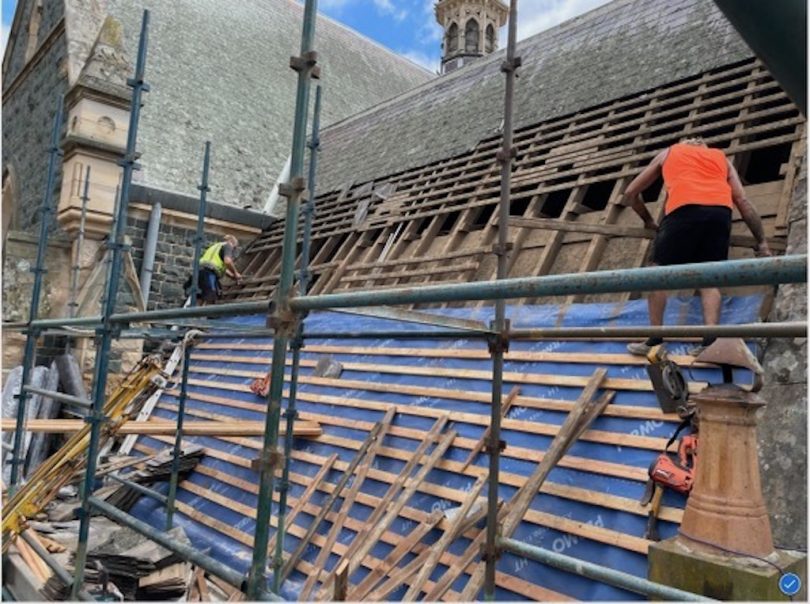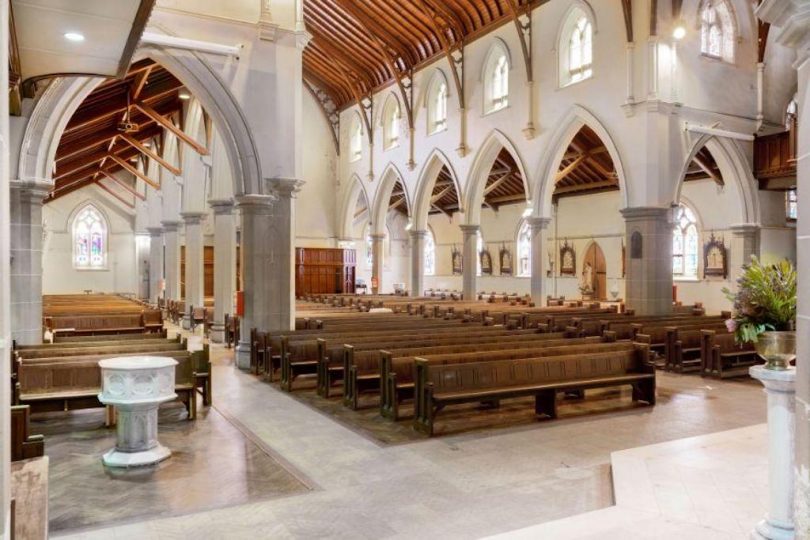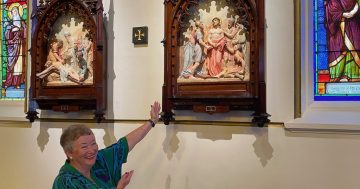
Slate long passed its use-by date is removed from Ss Peter and Paul’s Old Cathedral, Goulburn. Photos: Old Cathedral Restoration Committee.
Professional lighting illuminates the full splendour of Saints (Ss) Peter and Paul’s Old Cathedral in Goulburn as part of a multi-million-dollar restoration campaign video. The dramatic vision and music capture a sense of the cathedral’s glory and a glimpse of what’s to come, says chair of the restoration committee, Dr Ursula Stephens.
But even the professionally-made video can’t reveal the extent of historic treasures awaiting restoration and public display. Nor the challenges of major heritage restoration.
Industry specialists say the magnificent stained glass windows behind the altar, at the ground-level and above the nun’s sanctuary, have broken. Other pieces are missing or bowed while surrounding sandstone is cracked.
Repair and restoration will cost more than $1.7 million. These intricate Belgium, Britain and Goulburn-made windows which attract enthusiasts from all over the world are in a perilous state.
Dr Stephens says the timing and logistics of removing, crating up, repairing and refitting the windows has to work in with repainting the cathedral’s interior. It also means keeping the weather out in the meantime.
A separate video (unavailable publicly) reveals more of the once-hidden treasures. It shows what conservators discovered while cleaning the cathedral’s 150-year-old stations of the cross.
When ivory paint applied in about 1926 to each station to lighten up the cathedral came off during cleaning, it exposed a glimpse of the original colours.
Excited by the find, the conservators produced the 19-second video showing one of the station’s three crosses on Calvary in the background, and one of the figure’s pale skin tones and blue and pink garments – a stunning find according to Dr Stephens.
“We know we have to restore them all now,” she said.
A dynamic leader, Dr Stephens said, “It is a beautiful history project we are undertaking, a huge responsibility. The parish are the custodians of this amazing place, the Mother Church of the diocese which extended from Camden to the Victorian border originally.

Members of the Old Cathedral’s Repair, Restore, Renew committee Dr Ursula Stephens (chair), Trish Groves, Di Green and Matt Casey see their huge project responsibility as a rare privilege.
“We have a really rich library of resources including the bishop’s original library, exquisite documents such as an 1830s copy of Shakespeare when the presbytery was the Bishop’s House,” she said. “We have retained a lot of historical documentation here in the parish, while some of the archives have gone to the diocese in Canberra.”
The cathedral precinct will become much more than a place of Sunday worship, funerals and sacramental programs. The heritage-listed and rarely used St Brigid’s School, beside the cathedral, will become a heritage centre.
“We have an extraordinary amount of material we can put into a heritage centre and have facilities for pilgrims or visitors to the whole precinct,” Dr Stephens says.
First though, skilled artisans must finish pointing the sandstone and mortar between the cathedral’s rare greenstone, and more underpinning and drainage work to draw water away from the foundations. While out of site, this foundation work is painstakingly slow.
Inside, 104 pews have been removed and stowed. Each one will be stripped back, waxed and polished to its original colour. Heating will be attached under the pews and kneelers re-positioned. Removing the pews clears the way for repairing and restoring the vast expanse of parquetry flooring.

Lighting helps showcase the magnificent Old Cathedral.
Restorers sourced Penrhyn Heather Blue slate, also known as Bangor Blue, to replace the original tiles which came from the same Penrhyn quarry in North Wales. The quarry has been producing roofing slate since the 13th century.
Many more items of interest will become publicly accessible as the project continues to align with the NSW Heritage tourism strategy to bring more heritage tourism to the regions.
“We’re talking about pilgrimages, the way we can actually link into pilgrimages more broadly in Australia,” Dr Stephens says. “The pilgrimage industry is a growing industry in Australia and we think we have a lot to contribute in that space.”














